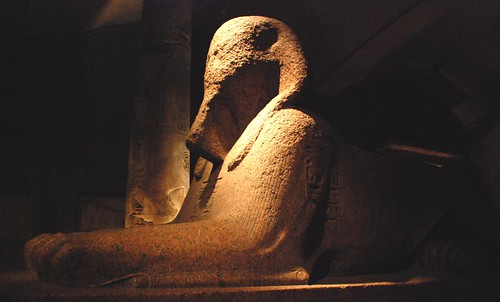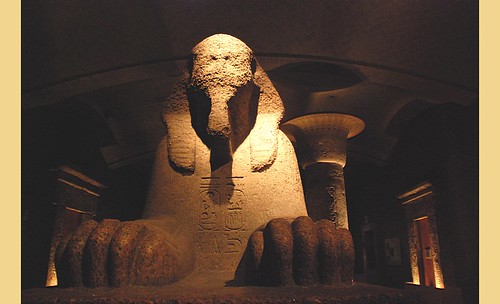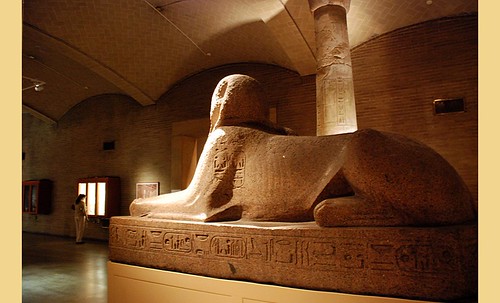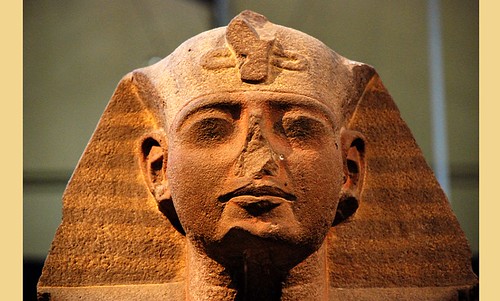
Cargado el 5 de noviembre, 2009
Galería de Hans Ollermann
King Ramses II (also called Ramses the Great) 1279-1212 B.C.

2007_0727_170139AA
The Sphinx once stood in the Palace of King Merenptah at Memphis, Egypt.
Dynasty 19, Reigns of Ramesses II and Merenptah (1279-1204 B.C.)
The Sphinx, a lion with a human head, represents the power of the Egyptian king. both to protect his people and to conquer the enemies of Egypt.
This Sphinx was burried up to its shoulders; only the exposed head was attacked by windblown sand, which eroded the facial features and the royal false beard. The inscriptions on the chest and around the base give the five names of Ramesses II. His son and successor Merenptah added his own cartouches to the shoulders after his father's death. This most impressive sphinx weighs about twelve tons. It was quarried at Aswan and transported by river to the Ptah Temple at Memphis, 600 miles away.
University of Pennsylvania Museum, Philadelphia.

2007_0727_170150AA
The Sphinx once stood in the Palace of King Merenptah at Memphis, Egypt.
Dynasty 19, Reigns of Ramesses II and
Merenptah (1279-1204 B.C.)
The Sphinx, a lion with a human head, represents the power of the Egyptian king. both to protect his people and to conquer the enemies of Egypt.
This Sphinx was burried up to its shoulders; only the exposed head was attacked by windblown sand, which eroded the facial features and the royal false beard. The inscriptions on the chest and around the base give the five names of Ramesses II. His son and successor Merenptah added his own cartouches to the shoulders after his father's death. This most impressive sphinx weighs about twelve tons. It was quarried at Aswan and transported by river to the Ptah Temple at Memphis, 600 miles away.
University of Pennsylvania Museum, Philadelphia.

2007_0727_170116AA
The third largest known Sphinx in the world in a majestic and almost magical setting of the University of Pennsylvania Museum.
The Sphinx once stood in the Palace of King Merenptah at Memphis, Egypt.
Dynasty 19, Reigns of Ramesses II and
Merenptah (1279-1204 B.C.)
The Sphinx, a lion with a human head, represents the power of the Egyptian king. both to protect his people and to conquer the enemies of Egypt.
This Sphinx was burried up to its shoulders; only the exposed head was attacked by windblown sand, which eroded the facial features and the royal false beard. The inscriptions on the chest and around the base give the five names of Ramesses II. His son and successor Merenptah added his own cartouches to the shoulders after his father's death. This most impressive sphinx weighs about twelve tons. It was quarried at Aswan and transported by river to the Ptah Temple at Memphis, 600 miles away.
University of Pennsylvania Museum, Philadelphia.

2007_0727_164043AA
Pharaostatue from the Temple of Harsaphes, Heracleopolis ( Thebes)
1897-1843 B.C.
On stylistic grounds, it is believed this statue was carved in the Middle Kingdom and later usurped by Ramesses II (1290-1224 B.C.), whose names are in the deep-cut inscriptions on the throne and base. An inset false beard has been lost.
University of Pennsylvania Museum, Philadelphia.

2007_0727_164226AA
Pharaostatue from the Temple of Harsaphes, Heracleopolis ( Thebes)
1897-1843 B.C.
On stylistic grounds, it is believed this statue was carved in the Middle Kingdom and later usurped by Ramesses II (1290-1224 B.C.), whose names are in the deep-cut inscriptions on the throne and base. An inset false beard has been lost.
University of Pennsylvania Museum, Philadelphia.
Ined
De Wikipedia, la enciclopedia libre
Mersejemra Ined, Mersejemra Neferhotep, o Ined, fue un faraón de la dinastía XIII de Egipto; gobernó de c. 1651 a 1648 a. C.[1]
Su nombre, Mersejemra Ined, está inscrito en un fragmento del Canon Real de Turín, en el registro VII, 6, indicándose que reinó tres años.
El término Ined, que aparece junto a su nombre en el Canon Real, debería ser un epíteto, o apodo, significando "pobre".
Los objetos atribuibles a este soberano proceden del Alto Egipto y confirman la teoría que sostiene que los últimos reyes de la dinastía XIII reinaban solamente sobre las regiones próximas a Tebas.
En torno a la época de Mersejemra, los reyes identificados comúnmente como hicsos, que dominaban el Bajo Egipto, conquistarán Menfis controlándolo directamente y hacen tributario a casi todo Egipto, dando así comienzo la dinastía XV.
Testimonios de su época [editar]
Mersejemra es citado en el Canon Real de Turín y la Lista Real de Karnak.
De este soberano se descubrieron dos estatuas, de buena factura artística, actualmente conservadas en el Museo Egipcio de El Cairo.
En las estatuas está grabado el nombre de Trono Mersejemra que J. von Beckerath y D. Franke asocian al nombre de Nacimiento: Neferhotep.
Titulatura [editar]
| Titulatura | Jeroglífico | Transliteración (transcripción) - traducción - (procedencia) |
| Nombre de Nesut-Bity: |
| mr sḫm rˁ (Mersejemra) Amado es el reinado de Ra (Lista Real de Karnak, nº 41) |
| Nombre de Nesut-Bity: |
| mr sḫm rˁ ind (Mersejemra Ined) Amado es el reinado de Ra, "pobre" (Canon Real de Turín nº 7,6) |
| Nombre de Sa-Ra: |
| nfr ḥtp (Nefer Hotep) Hermosa satisfacción (Según von Beckerath y Franke) |
Referencias [editar]
- Notas
- ↑ Krauss.
- Referencias digitales
- http://www.narmer.pl/dyn/13en.htm (en inglés)
| Predecesor: Suadyetu | Faraón Dinastía XIII | Sucesor: Hor II |
Neferhotep II.
aus Wikipedia, der freien Enzyklopädie
| Namen von Neferhotep II. | |||||||||||||||||
|---|---|---|---|---|---|---|---|---|---|---|---|---|---|---|---|---|---|
| Eigenname |
Nfr htp Vollkommen und zufrieden | ||||||||||||||||
| Thronname |
Mr.j-sḫm-Rˁ Geliebt von der Macht des Re | ||||||||||||||||
| Königspapyrus Turin (Nr.7/6) |
Mr.j-sḫm-Rˁ-... Geliebt von der Macht des Re, ... | ||||||||||||||||
Neferhotep II. war ein altägyptischer König (Pharao) der 13. Dynastie (Zweite Zwischenzeit), welcher etwa von 1691 bis um 1688 v. Chr. oder von etwa 1651 bis um 1648 v. Chr.[1] (s. Liste der Pharaonen) regierte.
Belege [Bearbeiten]
Der König regierte 3 Jahre und 1 Monat, sowie eine unbekannte Anzahl von Tagen. Zwei seiner Statuen fand man in der Cachette von Karnak. Auf den Statuen wird er Mersechemre und Neferhotep genannt. Im Königspapyrus Turin, 7.6 erscheint ein Mer-sechem-Re Ined und in der Königsliste von Karnak (VI 2) ein Mer-sechem-Re. Die Identifizierung dieser Belege folgt nach von Beckerath[2] Ryholt sieht dagegen in diesen Belegen zwei unterschiedliche Herrscher.[3]
Literatur [Bearbeiten]
- Jürgen von Beckerath: Untersuchungen zur politischen Geschichte der zweiten Zwischenzeit in Ägypten, Glückstadt 1964, S. 60, 254 (XIII 30)
- K.S.B. Ryholt: The Political Situation in Egypt during the Second Intermediate Period, Kopenhagen 1997, S. 356 (File 13/36) und 358-59 (File 13/b)
Einzelnachweise [Bearbeiten]
- ↑ Datierung nach Thomas Schneider: Lexikon der Pharaonen.
- ↑ von Beckerath: Untersuchungen
- ↑ Ryholt: The Political Situation, S. 358-59
| Vorgänger | Pharao von Ägypten 13. Dynastie | Nachfolger |
| Personendaten | |
|---|---|
| NAME | Neferhotep II. |
| ALTERNATIVNAMEN | Mersechemre; Neferhotep; Mer-sechem-Re Ined (Königspapyrus Turin); Mer-sechem-Re (Königsliste Karnak) |
| KURZBESCHREIBUNG | altägyptischer König der 13. Dynastie, um 1691 - um 1688 v. Chr. |
| GEBURTSDATUM | 18. Jahrhundert v. Chr. oder 17. Jahrhundert v. Chr. |
| STERBEDATUM | 17. Jahrhundert v. Chr. |
Queridos AE's:
--
Jaume Casanovas Folch
##########################################
RSS Feed de Amigos de la Egiptología
http://www.egiptologia.com/index.php?format=feed&TYPE=rss
##########################################
Todo sobre las Pirámides de Egipto
http://www.egiptologia.com/todo-sobre-las-piramides.html
Recomendamos: Instituto de Estudios Arqueológicos Bíblicos
http://www.ieab.net
--------------------------------------------------------------
LISTA DE DISTRIBUCIÓN DE AMIGOS DE LA EGIPTOLOGÍA - AE
Gestión Altas-Bajas y consulta mensajes enviados:
http://www.egiptologia.com/lista-de-distribucion.html
Moderador: Víctor Rivas egiptologia@egiptologia.com
Amigos de la Egiptología: http://www.egiptologia.com
Los mensajes de Amigos de la Egiptología son distribuidos gracias al apoyo y colaboración técnica de RedIRIS Red Académica Española - http://www.rediris.es





![D21 [r] r](http://es.wikipedia.org/w/extensions/wikihiero/img/hiero_D21.png)









![X1 [t] t](http://es.wikipedia.org/w/extensions/wikihiero/img/hiero_X1.png)
![Q3 [p] p](http://es.wikipedia.org/w/extensions/wikihiero/img/hiero_Q3.png)
![F35 [nfr] nfr](http://de.wikipedia.org/w/extensions/wikihiero/img/hiero_F35.png)
![R4 [Htp] Htp](http://de.wikipedia.org/w/extensions/wikihiero/img/hiero_R4.png)
![X1 [t] t](http://de.wikipedia.org/w/extensions/wikihiero/img/hiero_X1.png)
![Q3 [p] p](http://de.wikipedia.org/w/extensions/wikihiero/img/hiero_Q3.png)


![N5 [ra] ra](http://de.wikipedia.org/w/extensions/wikihiero/img/hiero_N5.png)

![S42 [sxm] sxm](http://de.wikipedia.org/w/extensions/wikihiero/img/hiero_S42.png)
![D21 [r] r](http://de.wikipedia.org/w/extensions/wikihiero/img/hiero_D21.png)

![M17 [i] i](http://de.wikipedia.org/w/extensions/wikihiero/img/hiero_M17.png)
![K1 [in] in](http://de.wikipedia.org/w/extensions/wikihiero/img/hiero_K1.png)
![N35 [n] n](http://de.wikipedia.org/w/extensions/wikihiero/img/hiero_N35.png)
![D46 [d] d](http://de.wikipedia.org/w/extensions/wikihiero/img/hiero_D46.png)
![G36 [wr] wr](http://de.wikipedia.org/w/extensions/wikihiero/img/hiero_G36.png)

No hay comentarios:
Publicar un comentario